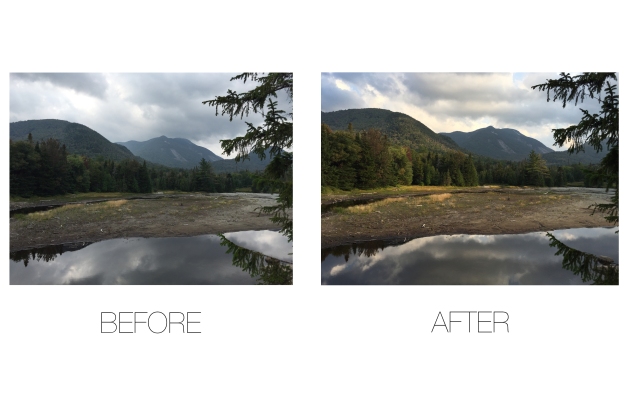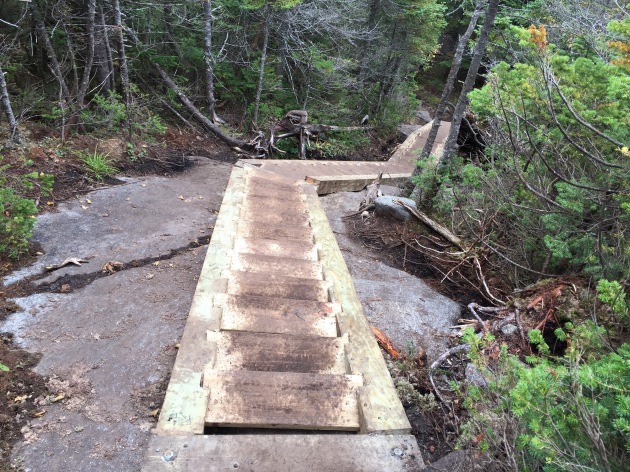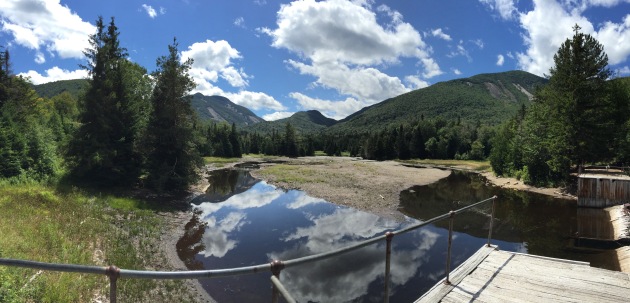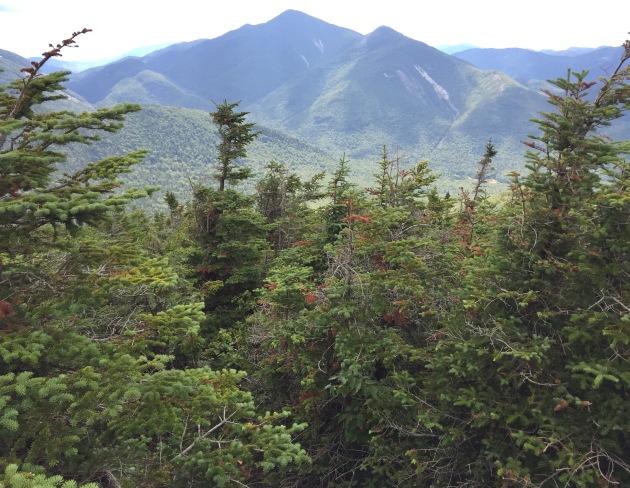August 31st, 2015
With half the High Peaks under my belt, one thing I have come to realize is the inanity in rating the difficulty of a mountain. To start, difficulty is very subjective and driven by circumstance — there’s a litany of factors which could make a trip a cinch or memorably tough. The most salient objection to the process is the multitude of paths (marked or not) leading to the top of many mountains, often of varying degrees of difficulty. Take Mount Colden, for instance.There are three common approaches to its top — from Lake Arnold, which by High Peaks standards is on the “easy” side; from Lake Colden which has the reputation of being one of the steepest trails in the ‘Daks; or up the Trap Dike, perhaps the most precarious and adventuresome undertaking of any. Given how different these three routes are, how could a single number be universally designated to represent a peak’s difficulty? If there is a mountain which speaks to the futility of such a task, Colden is it.
View to west from “False” Summit of Colden. “Real” Summit (left) and MacIntyre Range (center) in distance.
Conventionally, Colden is done as a loop, the Lake Colden and Lake Arnold trails paired together. The former, as it is steeper, is typically chosen for the ascent, with the more genial finish to Lake Arnold. In a flourish of intrepidity (well, not quite), I took Lake Arnold out and back.
On this day, I wasn’t sure whether I would tackle Colden or finish off what I had started with Wright and bag its bigger brother, Algonquin. I vacillated until the trail split, then I veered with great ambivalence to the left, Marcy Dam-bound. This was my first time doing the trail from said split to Marcy Dam, which I could now do blindfolded. (Now there’s an event idea for the ADK club!)
As I arrived at Marcy Dam, Colden had its head in the clouds. I hoped the time it took me to get up there would be enough for the clouds to have had their fill and move on.
I was making good time as I came upon a sign that said Lake Arnold was only half a mile. Shortly after this point, the trail was effectively a rock ridden stream. Time passed and I remarked to myself, ‘gee this is a long half mile.’ By now, I understood, mountain miles and street miles are two different species — but I was convinced I must have gone half a mile, mountain or otherwise. Disconcertingly, I began to descend and was confident Colden was up to my right and growing farther behind me. I was in an unenviable position — continue on possibly more off course or return and, if mistaken, lose hard earned ground which I would have to redo. Obstinate minded, I chose to continue on and grew more concerned with every step. I was really in the wilderness. I tussled with the idea of doing Skylight but I had not researched it enough.
My decision to turn around was made easier when passing over a boggy section on a log, which functioned more like a see-saw than a bridge. The muddy water looked like it was ankle deep until I fell in it and was submerged up to my waist. I would later learn this was the Feldspar Bog which I surmised it was from the map. I headed on back and finally saw Lake Arnold through the trees — I hadn’t before. Moments later, I came upon the sign for the turn-off to Lake Colden. What happened was I had my head down while balancing, like a tight-roper, over some puncheon and completely missed the big sign. All and all, I had unwittingly protracted my trip 2.5 miles (give or take half a mile).
New ladders near summit.
Lake Arnold wasn’t much to look at it, Miyoko calls it spooky and I can see why. Though, it must be a chic resort for mosquitos at the right time of the year. The trip up to Colden wasn’t terribly challenging, there were some brief steep parts but nothing outrageous. I came upon the “false” summit which had a view commensurate, if not better, than the “legitimate” summit. The false, the faux, the ersatz, the disingenuous summit, call it what you may, was more expansive than the real one. I descended back into the trees, over about three ladders down and up from the col, more steps-cum-ladders than the vertical variety. From what I gather, these ladders are new. Before the real summit, I had to sneak under a giant glacial erratic. It felt hazardous — what if the rock decided it was time to move and end its epoch-spanning sedentary lifestyle? Fortunately it did not, presumably it’s still there and conspicuous from the “false” summit.
View to west from “Real Summit.” Flowed Lands and Lake Colden (below to left).
Notwithstanding the overcast conditions, I was able to see Colden’s potential. I had expected it to be good — after all, Colden owns a prime piece of real estate, smack dab in the middle of the Macs and Marcy. Colden has bald summit characteristics but it isn’t a true bald summit. The baldness gene runs in the MacIntyre family but Colden’s balding looks like it’s in the early stages. It could use some Rogaine or an alpha-reductase inhibitor to thwart its fate of baldness. (For the record I’m being facetious). It’s not a lost cause like the Macs in this regard though, for the sake of views, visitors wish it were.
View to east: Marcy (left of center), Gray, Skylight, and Redfield. Giant way back in the distance (far left) and Great Range (to Giant’s right).
The first view I was treated with was to the west, of the Macs, about as good as any, and downward the slide which leads to Colden’s famous Trap Dike. The Trap Dike was not visible though Avalance Lake was, as well as Lake Colden and the Flowed Lands. A gentleman, of foreign descent, peered down the slide and asked if this were a way down. I said technically it was but you ought to know what you are getting yourself into. He heeded my advice and headed back the way he had come. Even Trap Dike enthusiasts are chary of the going down part.
Once the gentleman left, I was alone on the summit. On a nicer day, I am certain this would not have been the case. The two ledges, on either side, were rent asunder by a sea of cripplebrush. On the eastern side, the triumvirate of Marcy, Skylight and Redfield dominated the view, as a mostly foreshortened Great Range wound to Giant. As Colden shows its more interesting side to the MacInytre Range, the view, to the west, of the MacInytre Range, was more interesting and dramatic than the view to the east.
View from descent to Lake Arnold. South to east. Cascade and Big Slide (both left).
It can be argued no peak in the Adirondacks possesses as much character as Colden. Namely for its distinctive shape and its famed Trap Dike. Likewise, my dad thinks it’s the most distinguishable of them all based on pictures I have sent him. I hope to revisit on a nicer day sometime soon.



















